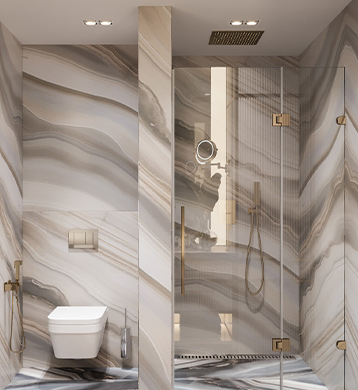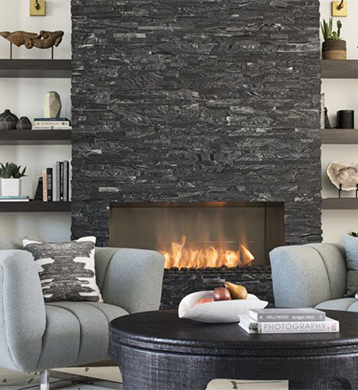There are several things to take into account when choosing which natural stone is ideal for you, whether you're creating a new space or making home improvements. Natural stone is utilized in interior design in a variety of ways, with granite and travertine being two of the most common types. In addition to other heavy traffic locations, granite is employed as worktops in kitchens and bathrooms. Persian travertine is frequently used in low-traffic parts of the house or for floors, backsplashes, and other surfaces. Both are untreated natural stones, available in various hues, and potentially pricey. There are some significant changes in any case. So that you can make the best decision, let's quickly review the differences, especially regarding the price.

The price per square foot for travertine ranges between $25 and $50. Granite and marble are both roughly $3 more expensive per square foot than travertine tiles. When renovating, travertine works well since it may give the room a posh appearance without breaking the bank.
Granite prices typically range from $35 to $75 per square foot and then increase. Thickness, appearance, porosity, and country of origin may all determine how much granite and travertine cost. High-quality natural stones include travertine and granite.
The cost of a new countertop, flooring or anything in need of stone to be built or installed is likely one of your top worries. Consequently, what can you anticipate paying for that amount of stone?
The amount of stone you need must first be determined in terms of square feet. Add the length and breadth of each segment together to select the area. You can obtain a quote after you know the square footage you want.
Factors that the price highly depends on it:
• The type of countertop material for installation
• Color and style of the stone
• The time it takes to install
• Size of the slab
• Bullnose and other shaped edges
The look of granite and travertine is one of the main distinctions between the two, and it is also the distinction that is most likely to affect your choice.
From pale white and beige to orange, gold, and even black, granite is available in a larger spectrum of hues. Additionally, occasionally contrasting flecks of each shade may be found, practically making the surface shimmer.
Travertine is only available in more muted hues like tan, gray, and white, although having a vast spectrum of colors. Vein-cut travertine, on the other hand, stands out for its lengthy veins, which are frequently of a contrasting color and truly make the surface of your choice pop.

Natural stones having a rigid surface include granite and travertine. However, because travertine is softer, granite prevails in a head-to-head durability contest.
Travertine surfaces, whether they are slabs or tiles, are still suitable for everyday use, even if granite does offer somewhat higher long-term durability. Travertine should be sealed regularly and protected from acidic stains with great care. There are some of the great surfaces you can choose travertine for them:
• Exterior Wall Cladding
• Interior Wall Cladding
• Exterior Floor Tiles
• Paving Stones
• Kitchen and bathroom countertop
• Shower tile
• Kitchen floor tile
• Exterior wall cladding
• Bathroom vanity tops
Stone materials are frequently used to make travertine tile. Tile made of travertine is utilized in outdoor spaces, floors, and backsplashes. Travertine is available in a wide range of tile types, including the wall, floor, and shower tiles. Pavers made of travertine are also available and may be utilized outside. A travertine floor, backsplash, or countertop is a lovely addition to the house.
Granite is typically utilized in slab form for vanities, backsplashes, kitchen countertops, and bathroom surfaces. While not particularly popular, granite tile is another alternative for this stone. Granite is one of the greatest building materials for enhancing your home's beauty and value.
Given how well they complement one another, granite and travertine are frequently used in kitchen designs. Granite is often utilized for countertop surfaces, while travertine is most commonly used for backsplashes, making them the ideal pair.
Hot springs have been significantly responsible for the limestone deposition known as travertine. Stalactites are mostly made of travertine and are rock formations that are found in caves. A natural but exquisite aesthetic may be seen in travertine often. White, tan, brown, and cream are the only neutral colors available for Iranian travertine. This natural stone is mined in Iran, Italy, Mexico, Turkey, and Peru, where travertine is transported to all over the world. The main Iranian origins are Abbas Abad, Azarshahr, Haji Abad, Atashkuh, Ask, Abyaneh, Dehshir, Takab, Abgarm, and Yazd.
As an igneous rock, granite is natural. The formation of granite in subterranean volcanic chambers takes hundreds or even thousands of years. The magma crystallizes slowly, causing it to form. Though other minerals are present in trace proportions, quartz and feldspar make up the majority of granite's composition. Brazil, India, Italy, and Canada are the primary exporters of granite to the world.
Both travertine and granite are porous stones, with travertine being significantly more permeable than granite. Because of this, both require routine upkeep to remain stain-resistant. Nevertheless, granite is regarded as a low-care stone; typically, it only has to be resealed once a year, if that. Travertine countertops, on the other hand, will need to be resealed every 3 to 4 months.
We have provided some tips for you in this regard:
✓ Spills should be immediately cleaned up. If anything spills, especially acidic items, juices, sauces, alcohol, or abrasive cleansers, wipe it up immediately.
✓ Use a natural stone cleanser and water to clean your counters often. On stone countertops, always use gentle cleaning agents authorized for such surfaces.
✓ Occasionally seal the surface. For travertine countertops, this is very crucial. Make use of a sealant made especially for kitchen countertops.
✓ The counter should not be directly touched by hot pans, despite the fact that both materials are pretty heat resistant.